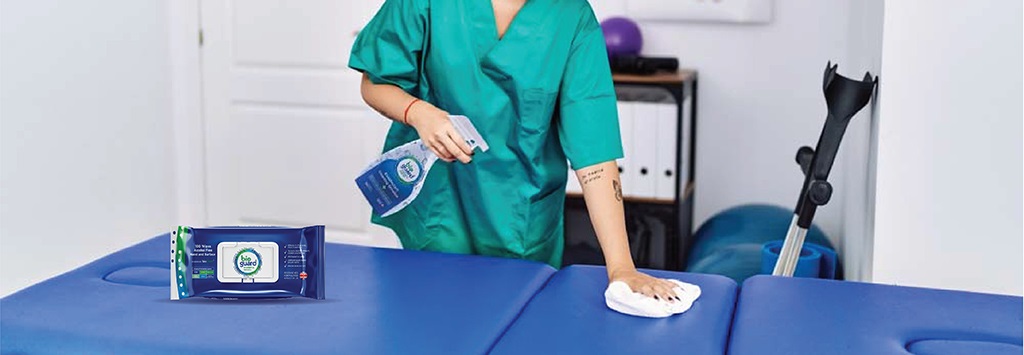
Health centres often make this mistake
Did you know this is an established fact?- HAIs contribute to increased morbidity, mortality and prolonged hospital stays. [1] Some of the common HAIs include surgical site infections (SSIs), vancomycin-resistant Enterococci bloodstream infections and those caused by methicillin-resistant Staphylococcus aureus (MRSA) and Clostridium difficile.
Considering the number of people who come in and out of hospitals, maintaining supreme standards of hygiene although vital, becomes challenging. A lack of cleanliness can trigger an increase in infection risk and HAIs, thereby endangering the wellbeing of patients, staff and visitors.
In their efforts to prevent HAI occurrences without going overboard with the budget, some medical centres invest in cheap chemical disinfectants, labelled as powerful. However, the short-term saving comes at an unanticipated long-term expense.
Cheap chemical disinfectants can lead to bigger expenses
While effective hygiene practices can be crucial for controlling various pathogens such as bacteria, viruses, spores, ESKAPE and MRSA, it is important to employ only high-efficacy disinfectants that can reduce HAI risks.
Conventional cleaning products are likely to be inefficient for decontamination, thereby remaining unsuccessful in reducing infection spread. [2] Chemical disinfectants are mostly composed of alcohol, chlorine and chlorine compounds, formaldehyde, glutaraldehyde, hydrogen peroxide, iodophors, ortho-phthaldehyde, peracetic acid, phenolics and quaternary ammonium compounds. These chemicals are corrosive, causing harm to the human health and potentially damaging expensive equipment. Some compounds also leave residues behind, causing risk to human health. As a result, disinfectants that seemed cheaper at first may lead to extremely high replacement costs.
Another major downside is that these chemicals tend to remain ineffective against various pathogens, such as AMR-resistant bacteria, spores and ESKAPE.
Cheaper disinfectants may seem to save money at first, but in the long run, they could prove to be more expensive. For instance, you may end up spending a huge amount in replacing expensive equipment damaged by corrosive disinfectants.
Like the saying goes “Penny Wise and Pound Foolish”, as you tend to be cautious about investing less money on low-quality disinfectants, you may end up facing great losses in the long run. It is best to invest resources on products that can destroy wide range of bacteria, viruses, spores, etc. while being environment-friendly and safe for public health. Moreover, the application should be simple so that it promotes easy application and killing of germs within a short duration.
How Bioguard can keep germs away, while being cost-effective
All Bioguard products are tested for their efficacy against various infectious agents, including spores, ESKAPE, MRSA and C.difficile. The unique formula comprising biochem makes our disinfectants robust, minimising infection transmission. Our disinfectants are easy to use, fast-acting and safe for medical equipment/environment.
Be Bioguard safe with our disinfectants that are:
- Trusted – Regularly used by healthcare professionals in over 25,000 sites across the UK, Europe and GCC in high-risk environments. Bioguard products are now protecting India.
- Proven – Independently tested to the gold standard European Norms [EN], EN13624:2013, EN13727:2012, EN14476:2013, EN17216:2018 & EN13704:2018, EN14348:2005, EN16615:2015 and EN1500.
- Robust – Broad Spectrum Microbiological Efficacy means our products are effective against a wide variety of organisms such as ESKAPE pathogens, Clostridium difficile spores, Mycobacterium, viruses, bacteria, including P. aeruginosa and fungi.
- Fast-Acting – It is effective in under 30 seconds*.
- Safe – Products are non-hazardous and non-toxic and have been MEA & VOC tested to ensure they are safe and do not cause skin rashes or harmful vapours to users, improving the likelihood of hygiene compliance and reducing the risk AMR.
- Multi-Surface – Applicable on virtually all surfaces (including fabrics and furnishings), so you can decontaminate the whole environment without causing degradation to surfaces, improving hygiene compliance and reducing the risk of AMR.
- Reliable – The product will remain effective in environments with high soiling levels, improving hygiene compliance and reducing the risk of AMR.
- Efficient – Combined cleaning and disinfection capability eliminates the need for multiple products, we can rationalise your product requirements, thereby saving inventory and reducing cleaning complexity levels, improving hygiene compliance and reducing the risk of AMR.
- Alcohol-Free* – Ensuring our product does not cause skin irritation is gentle when in contact with skin and meets certain users’ religious demands.


